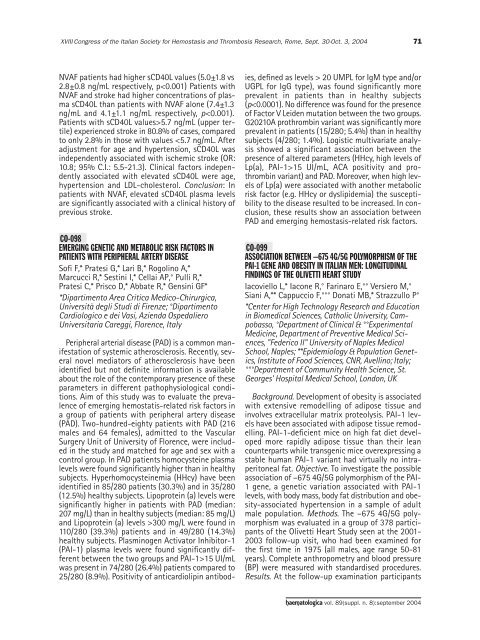Haematologica 2004;89: supplement no. 8 - Supplements ...
Haematologica 2004;89: supplement no. 8 - Supplements ...
Haematologica 2004;89: supplement no. 8 - Supplements ...
- No tags were found...
Create successful ePaper yourself
Turn your PDF publications into a flip-book with our unique Google optimized e-Paper software.
XVIII Congress of the Italian Society for Hemostasis and Thrombosis Research, Rome, Sept. 30-Oct. 3, <strong>2004</strong>71NVAF patients had higher sCD40L values (5.0±1.8 vs2.8±0.8 ng/mL respectively, p15 UI/mLwas present in 74/280 (26.4%) patients compared to25/280 (8.9%). Positivity of anticardiolipin antibodies,defined as levels > 20 UMPL for IgM type and/orUGPL for IgG type), was found significantly moreprevalent in patients than in healthy subjects(p15 UI/mL, ACA positivity and prothrombinvariant) and PAD. Moreover, when high levelsof Lp(a) were associated with a<strong>no</strong>ther metabolicrisk factor (e.g. HHcy or dyslipidemia) the susceptibilityto the disease resulted to be increased. In conclusion,these results show an association betweenPAD and emerging hemostasis-related risk factors.CO-099ASSOCIATION BETWEEN –675 4G/5G POLYMORPHISM OF THEPAI-1 GENE AND OBESITY IN ITALIAN MEN: LONGITUDINALFINDINGS OF THE OLIVETTI HEART STUDYIacoviello L,* Iacone R,° Farinaro E,°° Versiero M,°Siani A,** Cappuccio F,°°° Donati MB,* Strazzullo P°*Center for High Tech<strong>no</strong>logy Research and Educationin Biomedical Sciences, Catholic University, Campobasso,°Department of Clinical & °°ExperimentalMedicine, Department of Preventive Medical Sciences,"Federico II" University of Naples MedicalSchool, Naples; **Epidemiology & Population Genetics,Institute of Food Sciences, CNR, Avelli<strong>no</strong>; Italy;°°°Department of Community Health Science, St.Georges' Hospital Medical School, London, UKBackground. Development of obesity is associatedwith extensive remodelling of adipose tissue andinvolves extracellular matrix proteolysis. PAI-1 levelshave been associated with adipose tissue remodelling.PAI-1-deficient mice on high fat diet developedmore rapidly adipose tissue than their leancounterparts while transgenic mice overexpressing astable human PAI-1 variant had virtually <strong>no</strong> intraperitonealfat. Objective. To investigate the possibleassociation of –675 4G/5G polymorphism of the PAI-1 gene, a genetic variation associated with PAI-1levels, with body mass, body fat distribution and obesity-associatedhypertension in a sample of adultmale population. Methods. The –675 4G/5G polymorphismwas evaluated in a group of 378 participantsof the Olivetti Heart Study seen at the 2001-2003 follow-up visit, who had been examined forthe first time in 1975 (all males, age range 50-81years). Complete anthropometry and blood pressure(BP) were measured with standardised procedures.Results. At the follow-up examination participantshaematologica vol. <strong>89</strong>(suppl. n. 8):september <strong>2004</strong>
















